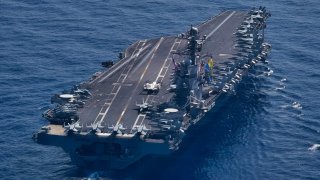The U.S. Navy's $14 Million Achilles Heel Revealed
The recent grounding of the USNS Big Horn, a critical Henry J. Kaiser-class replenishment oiler, has exposed a major vulnerability in U.S. Navy logistics.
What You Need to Know: The recent grounding of the USNS Big Horn, a critical Henry J. Kaiser-class replenishment oiler, has exposed a major vulnerability in U.S. Navy logistics.
-The incident, which temporarily sidelined the only oiler supporting the Abraham Lincoln Carrier Strike Group in the Middle East, highlights the aging support fleet and the strain on U.S. Navy logistics.
-While a U.S.-flagged commercial tanker was chartered to fill the gap at nearly double market rates, this event underscores the broader challenges, including the closure of the Red Hill Fuel Storage Facility, in maintaining reliable fuel supplies for naval operations.
US Navy's Refueling Struggles: USNS Big Horn Grounding Exposes Major Fleet Vulnerability
Last month, the U.S. Navy's greatest "Achilles Heel" was revealed when the Henry J. Kaiser-class replenishment oiler USNS Big Horn (T-AO-198) ran aground and partially flooded off Oman. The incident could have impacted operations of the Abraham Lincoln Carrier Strike Group – as the 33-year-old unarmed auxiliary support vessel was the only oiler in the Middle East.
The accident further highlighted the strain on U.S. Navy logistics and its aging support fleet in critical regions. The replenishment vessels, which are operated by the Military Sealift Command, carry fuel for U.S. Navy combat vessels as well as the jet fuel for the aircraft on the Navy's fleet of nuclear-powered aircraft carriers.
While the U.S. Navy maintains a fleet of 18 of the Henry J. Kaiser-class replenishment ships, with 15 being oilers –a full dozen are not double-hulled like most modern commercial tankers in service today, mandated following the Exxon Valdez oil spill. It could be an environmental catastrophe just waiting to happen.
But in the short term, while USNS Big Horn is sidelined, the U.S. Navy has charted a U.S.-flagged tanker operated by US Marine Management to fill the role. According to a report from gCaptain.com, the sea service has been forced to pay "nearly double the average market rate, underscoring the premium the government is willing to pay for securing U.S.-flagged vessels in military operations."
The report added that charter rates may be lower in the Pacific, but the U.S. Navy requires "reliability and adherence to specific national requirements" that drove up the costs. As a result, the Pentagon will be forced to foot a bill equally $38,356 daily – or $14 million for the first year. By contrast, medium-range (MR) tankers operating in the Pacific cost just $18,700 daily. Part of the issue is that the U.S. Navy put an emphasis on U.S.-flagged or reflagged vessels – citing national security concerns – and that almost certainly limited the options.
The U.S. Military Sealift Command (MSC) will oversee the contract, which could be extended up to five years – totaling as much as $73.3 million.
"The contract includes the stipulation that the tanker must carry at least 38,500 barrels of oil, primarily jet fuel, and must have the capability to transport two separate clean products simultaneously without sacrificing capacity," gCaptain added.
Closure of Red Hill Facility
The U.S. Navy was already facing a strain with refueling its surface combatants and other vessels after the Department of Defense (DoD) announced in March 2022 that it would close the Red Hill Fuel Storage Facility in Hawaii. The site, which was opened in 1940, could store up to 250 million gallons of fuel supporting military operations in the Indo-Pacific.
The order to close the facility came after 4,000 gallons of fuel inadvertently entered the fire suppression system and then was introduced into the U.S. Navy's drinking water at Joint Base Pearl Harbor-Hickam (JBPHH) in November 2021.
Without Red Hill in operation, the U.S. Navy increasingly relies on maritime transport to refuel its vessels.
"The increased costs of these charters reflect the Navy's need to secure fuel logistics in a region where geopolitical tensions continue to rise, ensuring that U.S. forces remain fully supplied despite the loss of a strategic onshore facility," gCaptain's report warned.
It is unclear now if even a single vessel will help fill the gap. Experts have suggested the U.S. would need at least 100 oilers in the event of a war with China in the Indo-Pacific, yet has fewer than a dozen.
Author Experience and Expertise: Peter Suciu
Peter Suciu is a Michigan-based writer. He has contributed to more than four dozen magazines, newspapers, and websites with over 3,200 published pieces over a twenty-year career in journalism. He regularly writes about military hardware, firearms history, cybersecurity, politics, and international affairs. Peter is also a Contributing Writer for Forbes and Clearance Jobs. You can follow him on Twitter: @PeterSuciu. You can email the author: [email protected].
Image Credit: Creative Commons and/or Shutterstock.


